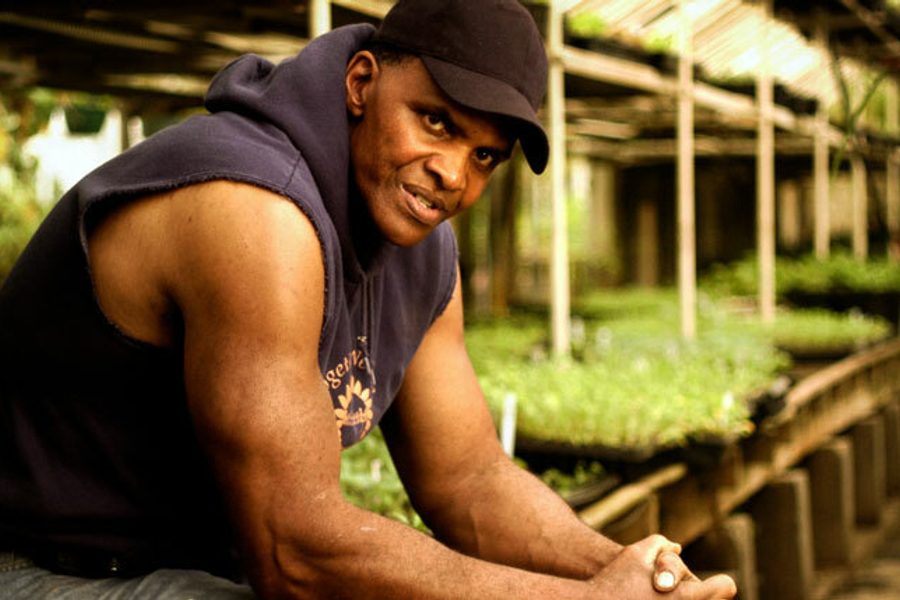
Five years ago, if you asked someone what ‘food justice’ means, you’d likely receive a blank stare. But that’s changing, thanks to urban farming pioneers such as Will Allen, one-time professional basketball player for the Baltimore Bullets (in the 1970s) and head of Growing Power, an urban farm in Milwaukee. In the early 1990s, Allen, then a Procter & Gamble employee who farmed in his free time, decided to purchase a run-down nursery in a low-income section of Milwaukee that was in foreclosure. Twenty years later, Growing Power has turned into a multipurpose community development organization with 140 employees and programs in both the Chicago and Milwaukee areas. In 2012 alone, Growing Power produced more than $750,000 in crops, raised 50,000 fish in its aquaponic beds, and composted more than 43 million pounds of waste.
Meanwhile, Allen has become a legend in urban farming circles for his innovative approaches to the craft of farming “in square feet,” as he describes it. This creativity won Allen a MacArthur Genius grant in 2008, making him only the second working farmer to ever win the award, and landed him on TIME’s 100 Most Influential People list in 2010.
Following a whirlwind year that saw the release of his book The Good Food Revolution: Growing Healthy Food, People, and Communities, Allen is ramping up his efforts to change the way we think about what we eat. Allen recently spoke with In These Times about his work and what it means to fight for “good food.”
What inspired you to found Growing Power?
In 1992, I was farming out in Oak Creek, Wisconsin, and working for Procter & Gamble in sales. When I was driving down the street [in Milwaukee] one day and saw the “For Sale” sign [for Growing Power], I thought it’d be a great place for me to sell my farm’s produce. About two years into the project, I got a call from a friend asking me to help a youth group. The kids wanted to grow an organic garden, but nobody would help them. I had some land out in back of the greenhouses, so I plowed it up and gave the kids some plants and seed. That year we had a very hot summer, kind of like this past summer. But no matter how hot it got the kids came, three days a week, to tend the crops. Folks from the Milwaukee Journal Sentinel came and did a front-page story. Then my friend said, “Well, why don’t you start a non-profit, since you like this work so much?” So I got kind of sucked into it. There was no master plan. It just kind of evolved.
Since then, you’ve had enormous success in popularizing urban farming. What comes next for Growing Power?
There are two major things we’re working on. The first is increasing our production to change the dynamics of the food system in southeast Wisconsin. Right now, less than one percent of our food is grown locally. We think that we can crank that up to 10 percent over the next several years. We’re a land trust, and we intend to put the land into long-term use for agriculture. The other thing we’re really trying to work on is getting our produce into the Milwaukee Public School system, and other school systems around southeast Wisconsin. So far, we’ve been able to get in our salad greens through Sysco, the designated company that delivers fruits, vegetables and other products to the schools.
Organic food is now abundantly available in health food stores and trendy restaurants. But what about outside of middle-class communities? How does economic inequality impact access to food?
Companies have devalued poor communities—all over the country, major grocery stores have pulled out from low-income areas. What’s left behind, often, are corner stores that aren’t exactly selling healthy food. The USDA says that you must live within a mile of a retail grocery store, otherwise you’re in a “food desert.” And Growing Power is located in a primarily African-American community, and it’s three and a half miles away from the closest grocery store. So it’s really important that we recognize the issue of racism around food.
How do you work to address this?
One of Growing Power’s core goals is to dismantle racism and inequality in the food system. This work is really about social and environmental justice, so it takes more than just growing healthy food and dropping it off in communities that need it. It has to be a combination of other things: educating folks on how to prepare the food, educating folks on how to access the food on a regular basis, and educating them on the need to break down bigger structures. One of our goals is to lower the cost of food production. If you can lower the cost of production, you can pass that on to other folks. So what we’ve been able to do is to get food to everyone in a community, whether you’re a billionaire, or they make five thousand a year, either by getting it into a grocery store, or a school, or by dropping it off as part of a CSA [Community-Supported Agriculture, a program that distributes locally farmed foods]. So communities have to become more proactive, ideally by growing more of their own food. Growing Power plans, over time, to install over 20,000 gardens in people’s backyards. To do that, you have to be able to work with good, healthy, chemical-free soil. We can’t just grow in any old soil, or on concrete or asphalt or rooftops. That’s why we put a big emphasis on soil this year and composted over 40 million pounds of carbon and nitrogen waste.
Beyond backyard gardens, what’s the future of urban farming?
For about five years, we’ve been working on a vertical farming project. It will have five greenhouses stacked on top of each other, as well as a large retail store and a space to teach culinary arts to younger folks before they go to college. Vertical farming is an idea that came from Dickson Despommier at Columbia University, who’s written that in the future, cities will have to grow food vertically. Cities like New York, Boston, Vancouver or Tokyo don’t have land like we do in the Midwest. But these cities are growing all the time, and those people will need to eat. Despommier has said that a 30-story building could feed fifty thousand people. We don’t really know if that’s true. It’s never been tested. So we need to get down and really quantify a lot of things that are currently just based on assumptions. How many fish do you have to raise through aquaponics, for example, to make that work into a funded, living-wage job? How many greenhouses do we have to build to be able to support a certain number of people with living-wage jobs, and how much food will those greenhouses produce?
How did you first become interested in farming?
I was born into it. My family has a long legacy of farming. My father was a sharecropper. In the ’30s, he dropped his plow and headed to the Washington, D.C. area. That’s where I grew up. While most African Americans at that time didn’t ever want their kids going back to that legacy, my father wanted myself and my brother to learn about farming. It was kind of a gift, because many of the things I do today are things I did when I was very young. When people ask me how I do this stuff, I say that my greatest asset is really my experience.
What type of food system do you eventually hope to build?
This system we’re building is much different than the industrial farming that’s producing the crops we use in our processed foods. Rather than thinking of agriculture in terms of acres, we’re thinking in terms of square feet. In the 1930s and 1940s, we had a local-regional food system. We weren’t shipping food across the country or overseas. These sorts of developments have represented major changes. In that sense, what we’re trying to do isn’t new. The new part is the creativity that’s making it possible, for example, to grow fish in urban areas because our lakes and oceans are polluted. The new system that we’re talking about is also much more cooperative, with hundreds of new categories
of jobs. Almost every occupation can be connected back to the food system: We’ll need engineers, architects, and carpenters working on food issues. This kind of innovation can move us toward the new system that we want to create.






